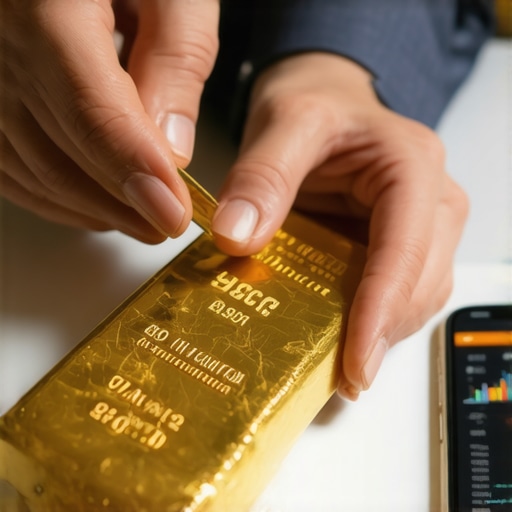Understanding Physical Gold Investment: A Beginner’s Guide
Investing in physical gold is an increasingly popular choice among individuals looking to secure their financial future. This precious metal has been a symbol of wealth and prosperity for centuries, and its allure continues to attract new investors. As a beginner, it’s essential to understand the fundamentals of investing in physical gold, including its benefits, risks, and various forms of gold investments available.
One of the primary advantages of physical gold is its ability to act as a hedge against economic uncertainty. In times of financial instability, gold often retains its value better than other assets, making it a safe haven for investors. This characteristic draws many to explore gold as a hedge against financial crises. Moreover, physical gold can provide a sense of security, as it is a tangible asset that you can hold in your hands, unlike stocks or bonds.
When considering investing in physical gold, beginners should be aware of the various forms it can take. Gold coins, bars, and bullion are some of the most common types of physical gold investments. Each type comes with its own set of advantages and potential drawbacks. For instance, gold coins are often more aesthetically pleasing and can be easier to sell, while gold bars may offer lower premiums over spot prices, making them a more economical choice for serious investors.
Key Factors to Consider Before Investing
Before diving into the world of gold investment, it’s crucial to consider several key factors. First, you need to determine your investment goals. Are you looking for long-term wealth preservation, or do you seek short-term gains? Understanding your objectives will help shape your investment strategy. Additionally, research the current market trends and fluctuations in gold prices. The top factors influencing gold prices can help you make informed decisions about when to buy or sell.
Another important aspect is the storage of your physical gold. Safeguarding your investment is vital, as theft or loss can lead to significant financial setbacks. Many investors opt for secure storage solutions, such as bank safety deposit boxes or specialized vaults. Additionally, consider obtaining insurance for your gold holdings to further protect your assets.
Finally, it’s wise to educate yourself on the different types of gold investments. Familiarizing yourself with the nuances of each option will empower you to make better decisions and enhance your overall investment strategy.
In conclusion, investing in physical gold can be a rewarding endeavor for beginners willing to do their homework. By understanding the benefits, risks, and various forms of gold investments, you can confidently navigate the gold market and secure your financial future. Whether you are interested in gold coins, bars, or bullion, the key is to remain informed and strategic about your investment choices.
Strategies for Maximizing Returns on Physical Gold Investments
To truly benefit from investing in physical gold, it’s essential to implement effective strategies that maximize your returns. One of the most critical strategies is timing your purchases and sales strategically. Understanding the market trends can significantly influence the value of your investment. As discussed in gold price analysis, being aware of the economic indicators that affect gold prices can help you decide the best times to enter or exit the market.
Additionally, diversifying your gold investments can mitigate risks. Instead of putting all your funds into one type of gold investment, consider a mix of coins, bars, and even gold ETFs. This approach allows you to balance potential gains and losses effectively. You might also want to explore different types of gold investments to create a well-rounded portfolio.
Understanding Gold Storage Options
Storage is another vital aspect of physical gold investment. The security of your gold can influence its value and your peace of mind. Many investors choose secure storage options such as bank safety deposit boxes or professional vault services. Each option comes with its own costs and benefits, so it’s crucial to evaluate which method aligns best with your investment strategy.
Investing in physical gold also requires considering insurance. Protecting your investment against theft or damage can save you from substantial losses. Research various insurance policies that cover precious metals to find the one that best fits your needs.
Evaluating Gold Market Trends
Staying updated on gold market trends is essential for any investor. The factors driving the demand for gold are numerous and can vary significantly. For instance, geopolitical tensions often lead to increased gold purchases as investors seek safe havens during uncertain times. By keeping an eye on these trends, you can adjust your investment strategy accordingly. Resources such as key insights on gold market trends can help you stay informed.
Another trend to watch is the impact of inflation on gold prices. Historically, gold has been considered a hedge against inflation, making it a popular choice during inflationary periods. Understanding how inflation affects the purchasing power of currency can guide you in making timely investments in gold.
The Role of Central Banks in Gold Demand
Central banks play a significant role in shaping gold demand. When central banks buy gold, it often signals confidence in the metal’s future value. Monitoring central bank purchases can provide insights into market sentiment and help investors make informed decisions. For further insights, check out the article on central bank gold purchases.
In conclusion, maximizing your physical gold investment involves strategic planning and continuous learning. By understanding market trends, diversifying your portfolio, ensuring proper storage, and staying informed about central bank activities, you can enhance your chances of achieving a successful investment outcome in the gold market.
Understanding the Impact of Economic Indicators on Gold Prices
Economic indicators play a crucial role in determining gold prices. Factors such as inflation rates, interest rates, and currency strength can significantly influence the demand for gold. For instance, when inflation rises, gold is often viewed as a safe haven, leading to increased demand. Conversely, when interest rates are high, investors may prefer interest-yielding assets over gold. Therefore, keeping an eye on these economic indicators can help you make informed decisions about the best times to buy or sell your gold investments.
Moreover, understanding market sentiment is vital. News events, such as political instability or changes in economic policy, can create volatility in gold prices. Regularly reviewing resources like gold market forecasts can provide insights into how these factors may affect your investments.
The Importance of Timing in Gold Investment
Timing your gold investments can greatly impact your returns. Many seasoned investors advocate for purchasing gold during market dips, as this can lead to higher profits when prices rebound. For example, if you are considering investing in gold coins or bars, monitoring market trends and price fluctuations is essential. Utilizing tools that analyze gold price movements, as discussed in analyzing gold price movements, can provide valuable data to help you decide when to invest.
Additionally, consider dollar-cost averaging as a strategy. This approach involves investing a fixed amount of money into gold at regular intervals, regardless of the price. This can reduce the impact of volatility and average out your purchase costs over time.
Exploring Gold Investment Options: A Comprehensive Overview
When it comes to investing in gold, there are several options available, each with its unique benefits and risks. You might explore options such as physical gold, gold ETFs, and gold mining stocks. Each of these investment types offers different levels of liquidity, risk, and potential returns. For instance, investing in physical gold, such as coins and bars, provides tangible assets that can be stored securely, yet it often comes with storage and insurance costs.
On the other hand, gold ETFs offer exposure to gold prices without the need for physical storage, making them a convenient option for many investors. If you’re interested in understanding more about these investment vehicles, check out exploring gold ETFs for insights into how to choose the right ones for your portfolio.
Assessing Risks Associated with Gold Investments
Every investment carries risks, and gold is no exception. The potential for price fluctuations can lead to significant losses if not managed carefully. It’s essential to evaluate your risk tolerance and investment goals before diving into gold investments. For example, while gold is traditionally considered a safe haven, its price can be influenced by various factors, including market speculation and changes in global economic conditions. To learn more about this topic, refer to the impact of economic uncertainty.
Furthermore, understanding the legal and regulatory aspects of gold investments is vital. Being informed about the laws regarding gold ownership, sales, and taxation can help protect your investment and ensure compliance.
Understanding Gold Investment Strategies
To optimize your gold investments, it’s essential to understand various strategies that can enhance your returns. From long-term holding to active trading, the approach you choose should align with your financial goals and risk tolerance. For instance, if you prefer a hands-off investment, buying physical gold and holding it for the long term could be ideal. This strategy allows you to benefit from the appreciation of gold prices over time without the stress of frequent trading.
On the other hand, active traders might opt for gold futures or ETFs, which can provide greater liquidity and the potential for short-term gains. If you’re interested in exploring this avenue, check out investing in gold futures for detailed insights on how to navigate this complex market.
Leveraging Gold ETFs for Portfolio Diversification
Gold ETFs have gained popularity among investors for their ability to diversify portfolios effectively. These funds track the price of gold and can be an excellent way to gain exposure without the hassle of managing physical assets. They are particularly appealing to those who want to invest in gold without incurring storage or insurance costs.
Moreover, investing in ETFs allows you to take advantage of market fluctuations while maintaining a liquid asset. For more information on how to choose the right ETFs, refer to exploring gold ETFs, which outlines key factors to consider when making your investment decisions.
Long-Term vs. Short-Term Gold Investments
Deciding between long-term and short-term gold investments is crucial for maximizing returns. Long-term investors usually buy gold with the expectation that its value will appreciate over time, making it a hedge against inflation and economic instability. This approach is often recommended for those looking to secure their wealth, particularly in uncertain economic climates.
In contrast, short-term investors may capitalize on price volatility, buying and selling gold based on market trends and news events. To better understand how to navigate these short-term strategies, explore resources like gold trading techniques, which provide essential tips for maximizing profits in a fluctuating market.
Conducting Thorough Market Research
Regardless of your investment approach, conducting thorough market research is critical. Monitoring economic indicators, geopolitical events, and trends in gold demand can provide valuable insights into potential price movements. Utilize analytical tools and resources to stay informed about market conditions. For a deeper understanding of how global factors influence gold prices, refer to how global demand impacts gold prices.
Additionally, engaging with expert analyses and market forecasts can help you make well-informed investment decisions. Keeping abreast of changes in the economic landscape is vital for all gold investors, whether you’re focusing on physical assets or trading through ETFs.
Exploring Gold Investment Risks
While gold investments can be lucrative, they are not without risks. Understanding these risks can help you make informed decisions. Market volatility is one significant risk; gold prices can fluctuate widely based on economic news, currency values, and geopolitical events. It is essential to stay informed about these factors to mitigate potential losses.
Another risk involves the physical aspects of gold investment. If you choose to invest in physical gold, you must consider storage and insurance costs. Additionally, there’s the risk of theft or loss, which can impact your overall investment strategy. For more insights on managing these risks, read managing gold investment risks.
Understanding Gold Price Volatility
Gold prices can be highly volatile, influenced by various economic factors such as inflation rates, currency strength, and interest rates. Investors should be aware of how these elements can affect gold prices. For instance, when inflation rises, gold often serves as a safe haven, driving prices up. Conversely, a strong U.S. dollar can lead to lower gold prices.
To navigate these price fluctuations effectively, consider employing strategies such as dollar-cost averaging, which can help mitigate the impact of volatility over time. Check out gold price volatility strategies for more tips.
Maximizing Returns Through Gold Investment
To maximize your returns on gold investments, it’s crucial to have a well-defined strategy. Start by determining your investment goals—whether you’re looking for short-term gains or long-term wealth preservation. This will guide your choices in the gold market.
Additionally, consider diversifying your gold investments. Mixing physical gold, ETFs, and mining stocks can balance risk and reward. Each type of investment has its strengths and weaknesses, and diversification can help you capitalize on different market conditions.
Importance of Timing in Gold Investments
Timing your entries and exits in the gold market can significantly impact your investment returns. Keeping a close eye on market trends and global economic indicators can help you identify optimal buying or selling points. Many successful investors utilize technical analysis to predict price movements and make informed decisions. To learn more about timing your investments, visit timing gold investments.
Frequently Asked Questions About Gold Investments
What are the benefits of investing in gold?
Investing in gold provides a hedge against inflation, portfolio diversification, and protection during economic downturns. It is often considered a safe-haven asset that retains value over time.
How do I start investing in gold?
To start investing in gold, you can purchase physical gold, invest in gold ETFs, or buy shares in gold mining companies. Research your options and choose an investment strategy that aligns with your financial goals.
Is gold a good investment during inflation?
Yes, gold is traditionally viewed as a strong investment during inflationary periods, as it tends to maintain its value when the purchasing power of currency declines.
How does gold compare to other investments?
Gold often serves as a diversification tool, providing stability in times of market volatility. Unlike stocks and bonds, gold is not tied to any company’s performance, making it a unique asset class.
What are the risks associated with investing in gold?
The main risks include market volatility, storage and insurance costs for physical gold, and potential theft or loss. Understanding these risks can help you make informed decisions.
Where can I buy gold?
You can buy gold from various sources, including online dealers, jewelers, and financial institutions. Ensure you choose a reputable seller and verify the authenticity of the gold.
How much gold should I include in my investment portfolio?
The amount of gold to include in your portfolio varies based on your financial goals and risk tolerance. Financial advisors often recommend allocating 5-10% of your portfolio to gold as a diversification strategy.
Can I invest in gold through my retirement account?
Yes, you can invest in gold through a self-directed IRA, which allows you to include physical gold, gold ETFs, and other precious metals in your retirement savings.
What are gold ETFs?
Gold ETFs are exchange-traded funds that track the price of gold, offering investors a way to gain exposure to gold without owning physical bars or coins. They provide liquidity and flexibility for trading.
Authority Resources for Gold Investment
For further research and insights on gold investing, consider the following trusted resources:
- World Gold Council – Offers research, insights, and statistics on gold investment trends.
- Investopedia – Provides educational articles on various investment strategies, including gold.
- Kitco News – A reliable source for real-time gold market news and analysis.
- BullionVault – A platform for buying and storing physical gold securely.
- Forbes – Offers expert opinions and analysis on gold investments and market trends.
Conclusion
Investing in gold is a compelling strategy for diversifying your portfolio and protecting your wealth. By understanding various investment approaches, risks, and market dynamics, you can make informed decisions that align with your financial goals. Whether you are considering physical gold, gold ETFs, or mining stocks, staying informed and strategic in your investments will enhance your potential returns in the ever-changing gold market.











This was a very comprehensive look at physical gold investing, especially for someone new like me. I appreciate how it detailed not just the benefits, but also the risks and the importance of proper storage and insurance. I’ve always been interested in gold as a hedge, but hadn’t thought much about the actual forms of gold—coins, bars, bullion—and the pros and cons of each. One thing I’m curious about is the practical side of storage; I live in an apartment and wonder what safe, affordable storage solutions you would recommend for a beginner. Also, the aspect of diversifying within gold investments stands out. Do you think holding a mix of coins and ETF exposure is a better balanced approach for new investors, or is starting with physical gold a good first step? Would love to hear insights from others who are just beginning their journey into physical gold.